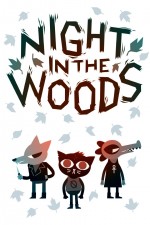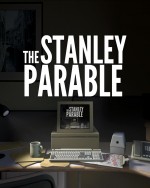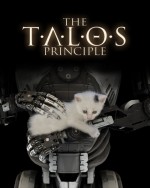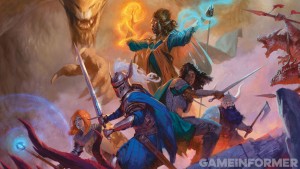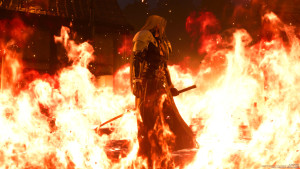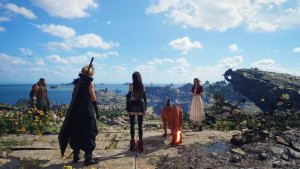Please support Game Informer. Print magazine subscriptions are less than $2 per issue
Five Games That Will Give You An Existential Crisis

Do you ever wonder why we’re here? Have you ever contemplated the meaning of life? Does dread ever overtake you for seemingly no reason? If so, you’re either experiencing an existential crisis… Or you’re playing a video game.
Equal parts identity crisis and dread, an existential crisis stems from the fear, confusion, and despair of losing a guiding principle or belief in life. Everyday causes such as moving homes or losing a job can trigger an existential crisis and make you call into question the very fabric of reality as we understand it. Easy to catch but difficult to shake, this unsettling, visceral experience has become a popular focus in video games.
We’ve assembled a list of five games tackling existence, consciousness, and the meaning of life that will leave you crushed by the weight of existential angst.
WARNING! This list contains spoilers for The Stanley Parable; Soma; Nine Hours, Nine Persons, Nine Doors; The Talos Principle; and Night in the Woods (listed in order). If you want to experience a title’s existential crisis firsthand, skip that entry!

The Stanley Parable
What’s it about? Ostensibly, this PC adventure game tells the story of Stanley, a boring man working a boring job whose every action is observed by an omnipresent narrator. The narrator attempts to guide Stanley through a script he has written using verbal prompts, which players can then follow or ignore. Whether hints are obeyed or disobeyed opens new paths for Stanley to explore and prompts more dialogue from the narrator as he adapts the tale to players’ choices.
What’s the crisis? Lurking below the seemingly straightforward surface of The Stanley Parable is a deviously profound take on choice and freedom, two important aspects of existentialism. As soon as the game begins, players are faced with choices that must be made. These decisions range from obvious questions like “Should I obey the narrator?” to the more subtle “Should I do anything at all?”
For example, if players close the door to Stanley’s office instead of leaving like the narrator asks, the narrator berates Stanley for his inability to make decisions for himself. Of course Stanley makes no decisions for himself – players decide for him. On the other hand, if players hide in a broom closet and refuse to participate in the story, the narrator will ridicule them specifically, not Stanley, and board up the closet door in future playthroughs, denying them access.
In its own gleefully irreverent way, The Stanley Parable reminds us that choice is something we are faced with every moment of every day. Playing the game is a choice. Quitting the game is a choice. One cheeky achievement (“Go Outside”) even points out that buying the game and not playing it is a choice. That level of freedom can be terrifying, and the creepy turns Stanley’s tale can take will leave your heart pounding with existential dread without resorting to a single jump scare.

Soma
What’s it about? A survival horror game that focuses on narrative and atmosphere, Soma’s storyline can best be described as one existential crisis after another. The victim of a catastrophic car crash, protagonist Simon Jarett falls asleep during an experimental brain scan procedure to find a cure for his lethal brain hemorrhage. Later, he wakes up in an underwater research facility overrun by violent robots. Terrified and confused, Simon quickly realizes the world as he understood it is gone, replaced by an uncertain and unforgiving future he tries desperately to escape.
What’s the crisis? Soma dives deep into the core of the human experience: what is the self? Is it our bodies? Our brains? Our memories? Existentialism charges every individual with creating a personal identity, but also holds that our identity is tied to our past and our actions. So which one really matters?
This is the question Simon must ask himself throughout his journey, since the Simon who wakes up in Pathos-II is not the same Simon who fell asleep in Toronto. He is Toronto Simon’s brain scan installed in a new, mechanical body. The original Simon woke up from the procedure and resumed his normal life before dying a few months later, meaning future Simon is not only missing a human body and brain, but also key memories. Yet he is still somehow distinctly Simon.
What is this indescribable something that makes us who we are? Soma suggests that it boils down not to our bodies or our pasts, but to our actions. Simon goes through many transformations and crises, yet the one thing that remains constant are the effects of his choices. Did he value human life over robotic life? Did he leave his clone alive or shut it down? Our actions don’t just affect us, they define us, a frightening responsibility because we must always live with the consequences.

Nine Hours, Nine Persons, Nine Doors
What’s it about? The last thing Junpei remembers is coming home to someone in a gas mask knocking him out with a cloud of white fog. When he wakes up, he’s trapped on a sinking ship with eight strangers, all of whom have been selected to participate in a game of life and death known as the Nonary Game. In this dark visual novel, players must solve puzzles, gather clues, and search not only for a way to escape, but also the truth behind the twisted origin of the Nonary Game.
What’s the crisis? What are our thoughts? Where do they come from? Are we truly individuals? Or is there some unseen force making our decisions for us?
Junpei’s eight companions each present their own views on these questions, aided by supernatural theories that push the boundaries of reality as we understand it. Some of them believe in ghost-writing, some in superstition, and some in conspiracies. The most important of their reality-bending theories is called morphogenetic resonance, an invisible field that transmits information telepathically through space and time.
The stories the Nonary Game victims tell are existentially unsettling because they instill doubt in the reality and individuality we take for granted. If something like the morphogenetic field is real, it shakes the foundations upon which we have built our identities, calling into question everything we believe. We may not even be ourselves – we may just be a monitor displaying the machinations of one true computer, the ultimate form of existential despair.

The Talos Principle
What’s it about? Similar to games like Portal and The Turing Test, The Talos Principle casts players as a newly-activated android who must solve spatial puzzles under the guidance of a disembodied voice called Elohim, Hebrew for “god.” Elohim tells the android its purpose in life is to complete puzzles, gather sigils, and open new areas to prove its worth, after which Elohim will grant it eternal life.
What’s the crisis? Despite the apparent beauty of the world and benevolence of Elohim, the more players explore and discover, the more they realize a sense of wrongness pervades the world. What’s the point of the puzzles and sigils? Who is leaving messages for the android telling it to disobey Elohim? And why doesn’t Elohim want the android to enter the mysterious tower?
In this future where humans are already extinct and all that’s left are robots, A.I.s, and other machines trapped in a virtual space, the search for meaning may seem moot. This makes it tempting to go along with Elohim’s expectations and follow the role he assigns the android, much like existentialists say it is tempting for individuals to go along with the role society gives them. Yet choosing our own path in life is an important practice, without which we fall into an existential crisis.
By starting with a purpose they did not choose and do not understand, players are encouraged to defy that purpose and search for their own. They ask why they should collect the sigils. They wonder whether the enemy robots are actually dangerous. They question Elohim and go off the path he has set for them. Even though this way is much more difficult and intimidating, the android’s quest to find its own purpose is a powerful statement on the importance of choosing a path for ourselves.
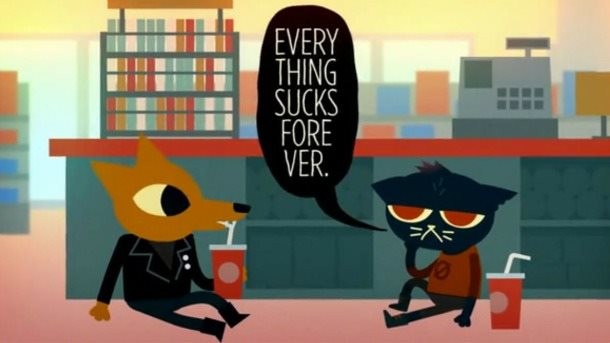
Night in the Woods
What’s it about? Taking place in a world of anthropomorphic animals, this narrative-rich 2D adventure in the vein of games like Kentucky Route Zero stars recent college drop-out Mae Borowski. Like most 20-year-olds, Mae doesn’t really know what to do with her life. Aimless and lonely, she moves back to her small hometown, Possum Springs, where nothing ever changes. Yet much to her dismay, time has actually gone on in her absence: beloved local businesses have gone bankrupt, friends have moved on, and dark forces are at work behind the scenes.
What’s the crisis? Mae’s existential struggle to find her place in the world is easily identifiable to players because of how real her emotions are. She stresses about parties, argues with her parents, and uses video games to escape from reality. Until one day, where Mae suddenly finds herself unable to relate to the world around her. The video game she loved is just code, and the people around her aren’t people, just meaningless shapes.
Ever since Mae lost the ability to identify with others, she has been trying to find meaning in a world she perceives as empty. Her existential angst eventually takes the form of a cold, uncaring being who hints that Mae’s death is forthcoming. This creature represents despair and is worshipped by a cult in town, each member of which stands for Mae’s own doubts. The cultists make sacrifices to the creature by throwing things into “the hole at the center of everything,” referencing the vicious cycle of Mae’s erratic attempts to fill the source of her feelings of emptiness.
With the help of her friends, who stand for friendship, love, and other meaningful aspects of life, Mae confronts the cult. Her injuries from the fight symbolize all the emotional and psychological damage she’s endured at the hands of her own doubts, but she pushes on despite the pain. Mae overcomes her depression by refusing to die and give up on life. Her injuries then miraculously heal, the final indication that Mae has let go of her angst and chosen to live on thanks to the meaning of life she has discovered through friends, family, and home.
With androids, office workers, and combinations of the two, video games will continue to find new ways to challenge and surprise us with creative storytelling approaches. Existentialism’s emphasis on choice relates well to the interactivity of video games, blending gaming and philosophy in powerful new ways. An existential crisis can make a game more meaningful and memorable for players – just don’t blame us if the tingle never quite leaves your spine.
Tell us about your favorite philosophically-inspired video game musings in the comments below – once your existential crisis is over, that is.
